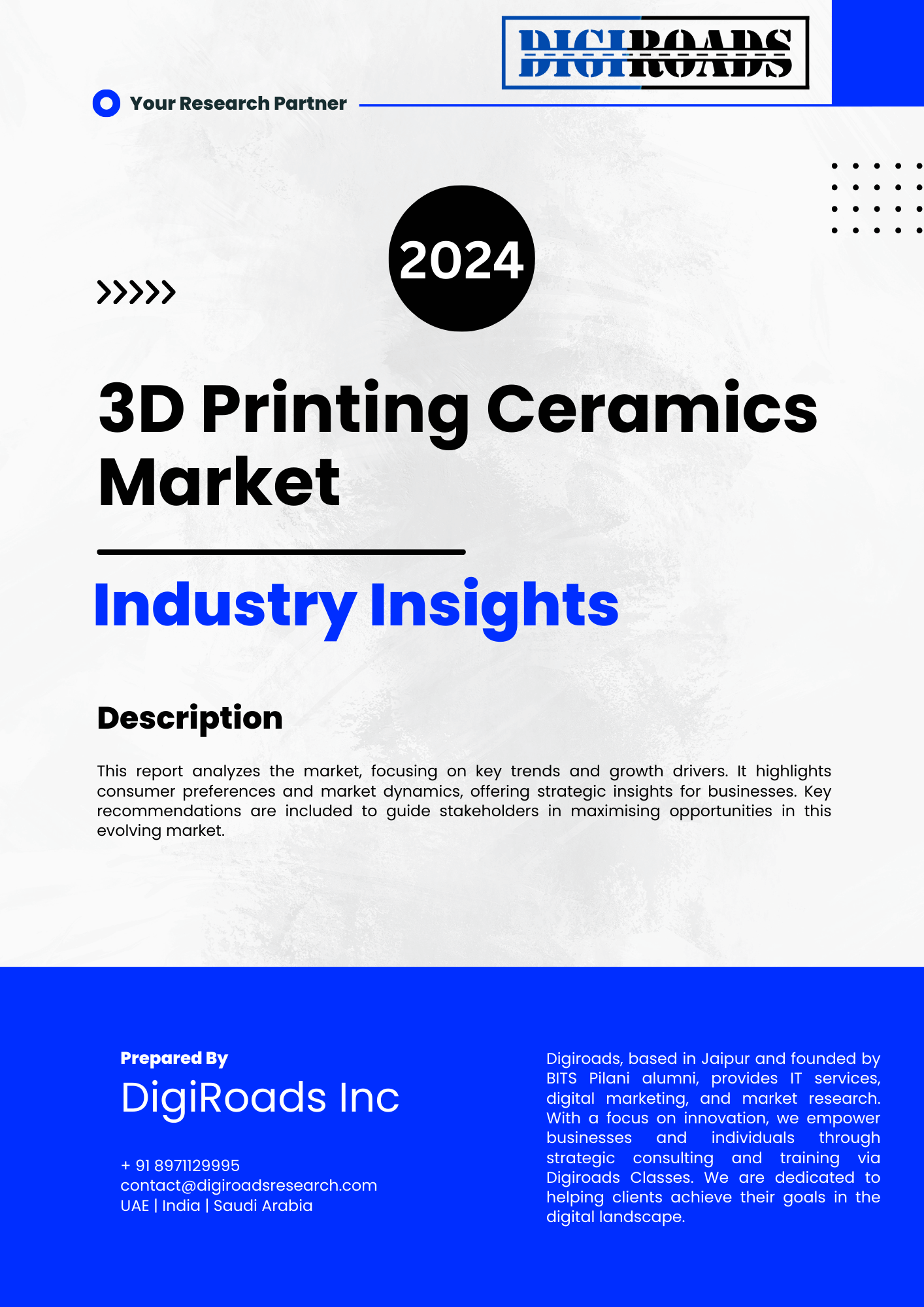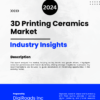No products in the cart.
3D Printing Ceramics Market
- Brand: DigiRoads
The “3D Printing Ceramics Market” report spans 120 pages, detailing market trends, growth drivers, technological advancements, and competitive landscape. It offers insights into applications, regional analysis, and future forecasts, highlighting the sector’s rapid expansion and innovation.
Category: Chemicals and Materials
Brand: DigiRoads
3D Printing Ceramics Market: Opportunity Analysis and Industry Forecast, 2024-2034
3D Printing Ceramics Market Overview:
Global 3D Printing Ceramic market is valued at USD 286.24 Million in 2024 and is projected to reach a value of USD 3967.59 Million by 2034 at a CAGR of 30.01%.
The 3D printing ceramics market has witnessed significant growth owing to the burgeoning demand for high-performance materials in various industries. With advancements in additive manufacturing technologies, ceramic materials have gained prominence due to their unique properties such as high strength, heat resistance, and electrical insulation.
Key drivers propelling market growth include the expanding applications of ceramics in aerospace, healthcare, electronics, and automotive sectors. In aerospace, 3D printed ceramics are utilized for manufacturing lightweight and durable components, enhancing fuel efficiency and performance. Similarly, in healthcare, ceramic implants are preferred for their biocompatibility and ability to mimic natural bone structure, fostering rapid adoption in medical devices and prosthetics.
Moreover, the market is characterized by innovative product developments and strategic collaborations among key players to enhance material properties and manufacturing processes. However, challenges such as high production costs and limited scalability hinder widespread adoption.
As the industry continues to evolve, technological advancements and the development of novel ceramic materials are expected to drive further market expansion, catering to diverse industrial applications and fostering innovation in additive manufacturing.
3D Printing Ceramics Market- Report Coverage:
The “3D Printing Ceramics MarketReport – Forecast (2024-2034)” by Digiroads Consulting, covers an in-depth analysis of the following segments in the 3D Printing Ceramics Market.
| Attribute | Segment |
| By Type |
|
| By Form |
|
| By End User |
|
| By Location |
|
3D Printing Ceramics Market Recent Developments :
Material Developments: Research and development in creating new ceramic materials specifically designed for 3D printing is ongoing, expanding the design possibilities for manufacturers .
Bioprinting Applications: Collaboration between companies and research institutions is fostering the use of 3D printed ceramics in bioprinting for medical applications like bone grafts .
Aerospace Industry Integration: 3D printed ceramics are being explored for their heat resistance and other properties, making them suitable for components used in spacecraft .
Overcoming Challenges: While the market is promising, challenges like relatively high costs and lower adoption rates in some regions still exist. However, the continuously evolving 3D printing material market offers hope for future advancements
3D Printing Ceramics Market- Dynamics:
Technological Advancements: Continuous innovation in 3D printing technologies, such as binder jetting and stereolithography, enhances the precision, speed, and scalability of ceramic manufacturing, driving market growth.
Material Development: Research and development efforts focus on creating advanced ceramic materials with improved properties like strength, thermal conductivity, and biocompatibility, expanding the application scope in diverse industries.
Industry Verticals: Increasing adoption of 3D printed ceramics in aerospace, healthcare, automotive, and electronics sectors due to their unique properties and performance benefits drives market demand and growth opportunities.
Regulatory Landscape: Compliance with industry standards and regulations governing material safety, quality, and performance is crucial for market players to ensure product acceptance and market penetration.
Strategic Partnerships: Collaborations between material suppliers, 3D printer manufacturers, and end-users facilitate technology integration, product development, and market expansion, fostering innovation and competitiveness.
Cost Considerations: Addressing production costs, including material expenses, equipment investments, and process optimization, is essential to enhance market viability and competitiveness, especially for mass production applications.
Key Market Players:
Product/Service launches, approvals, patents and events, acquisitions, partnerships and collaborations are key strategies adopted by players in the 3D Printing Ceramics Market. The top 10 companies in this industry are listed below:
- 3D Systems Corporation (US)
- Stratasys, Ltd. (US)
- Materialise NV (Belgium)
- Arkema SA (France)
- Evonik Industries AG (Germany)
- General Electric (US)
- The ExOne Company (US)
- Hoganas AB (Sweden)
- Royal DSM N.V. (Netherlands)
Key Benefits For Stakeholders:
Improved Product Performance: Manufacturers can leverage 3D printing ceramics to produce components with enhanced mechanical properties, thermal stability, and chemical resistance, leading to superior product performance in diverse applications.
Cost Efficiency: 3D printing enables the production of complex ceramic geometries without the need for expensive tooling, reducing manufacturing costs associated with traditional methods and offering cost-effective solutions for both prototyping and production.
Time Savings: Rapid prototyping capabilities of 3D printing ceramics expedite product development cycles by allowing quick iteration and validation of designs, leading to faster time-to-market and competitive advantage.
Customization and Personalization: The flexibility of 3D printing enables stakeholders to customize ceramic parts according to specific requirements, catering to individual customer needs and niche market segments, thus unlocking new business opportunities.
Sustainability: Compared to traditional manufacturing processes, 3D printing ceramics generate less material waste and consume fewer resources, contributing to sustainability initiatives and reducing environmental impact.
Market Differentiation: Adopting 3D printing ceramics enables stakeholders to differentiate their products in the market by offering innovative solutions with unique design features, material properties, and performance characteristics, strengthening their market position and brand value.
Supply Chain Resilience: Localized additive manufacturing capabilities reduce dependence on global supply chains for ceramic components, mitigating risks associated with supply chain disruptions and enhancing business continuity.
Collaborative Opportunities: Collaboration among stakeholders, including material suppliers, technology providers, and end-users, fosters innovation, knowledge sharing, and ecosystem development, driving collective growth and market advancement.
We have studied 3D Printing Ceramics Market in 360 degrees via. both primary & secondary research methodologies. This helped us in building an understanding of the current market dynamics, supply-demand gap, pricing trends, product preferences, consumer patterns & so on. The findings were further validated through primary research with industry experts & opinion leaders across countries. The data is further compiled & validated through various market estimation & data validation methodologies. Further, we also have our in-house data forecasting model to predict market growth up to 2034.
Contact us for any inquiry.
Table of Contents
- INTRODUCTION
1.1 Study Assumptions & Market Definition
1.2 Scope of the Study
- RESEARCH METHODOLOGY
- EXECUTIVE SUMMARY
- MARKET DYNAMICS
4.1 Market Overview
4.2 Market Drivers
4.3 Market Restraints
4.4 Porter’s Five Forces Analysis
4.4.1 Bargaining Power of Suppliers
4.4.2 Bargaining Power of Buyers
4.4.3 Threat of New Entrants
4.4.4 Threat of Substitute Products
4.4.5 Intensity of Competitive Rivalry
- MARKET SEGMENTATION
- 3D Printing Ceramics Market– By Type
- Oxide-Based
- Non Oxide-Based
- 3D Printing Ceramics Market– By Form
- Powder
- Filament
- Liquid
- By End User:
- Automotive
- Aerospace & defense
- Healthcare
- Consumer Goods
- Construction
- Others (Electronics, Education, Food, etc.)
- By Location
- North America
- Europe
- Asia-Pacific
- Latin America
- Middle East & Africa (MEA)
- COMPETITIVE LANDSCAPE
6.1 Most Adopted Strategies
6.2 Market Share Analysis
6.3 Company Profiles
- 3D Systems Corporation (US),
- Stratasys, Ltd. (US),
- Materialise NV (Belgium),
- Arkema SA (France),
- Evonik Industries AG (Germany),
- General Electric (US),
- The ExOne Company (US),
- Hoganas AB (Sweden)
- Royal DSM N.V. (Netherlands)
- MARKET OPPORTUNITIES AND FUTURE TRENDS


